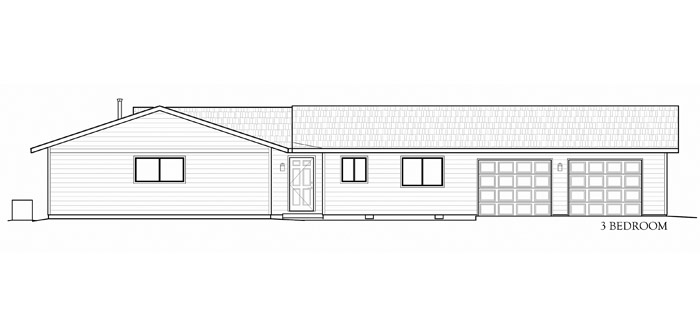(An example of a unit to be rehabbed and converted from two-bed to three-bed, utilizing garage space to create more large family-style living | Rendering courtesy of Travois)
Confederated Tribes Land Tax-Credit Funding for Reservation Homes Update
Much needed housing improvements to the tune of $7.8 million are in the works for a cluster of units on the Confederated Tribes of Warm Springs Reservation in Central Oregon thanks to an innovative tax credit program.
The project, which covers site improvements and rehabilitation of 18 homes, is being funded through a Low-Income Housing Tax (LIHTC) award from Oregon Housing and Community Services (OHCS) which facilitates such initiatives in the state.
The development is Warm Springs Housing Authority (WHSA’s) second LIHTC project, after it also previously won a similar scenario to construct 35 new single-family homes on the Warm Springs Reservation’s Greely Heights subdivision.
The latest project consists of remodeling systems, finishes and thermal envelopes in 14 duplex units and four single-family units, originally built in the 1970’s, with surrounding sitework and new construction of a 500-square-foot storage and laundry building.
The remodeled area spans some 16,926-square-foot of space in two-bed home plans, with a bedroom to be added to four units in the garage area, and two units to have bed and bath added in the current garage.
Site 1, known as Foster-Sheerer, includes the rehabilitation of four single-family homes and five duplex buildings, with a total of ten units. The new laundry building will also be built at this site.
Site 2, Elk Loop, will involves remodeling two duplex buildings with a total of four units, including an additional bedroom to be added to each of the four units.
The housing units are two- and three-bedroom floor plans and all 18 units are targeted to households with annual incomes up to 60 percent of the Area Median Income (AMI). Many amenities are located a short distance (1.5 miles or less) from both sites, including a community center, grocery store, bus station, K-8 schools, a park and a hospital and emergency medical services. Residents also have convenient access to adult and family services.
Daniele Wood, executive director of WSHA, which has developed over 400 units of affordable housing for tribal members, said, “This project involves much-needed updating of older units to bring them up to modern standards in terms of everything from livability to energy efficiency.
“Praise must go to OHCS as this would not have been possible without their assistance and they were key in providing gap funding.”
The LIHTC provides a tax incentive to construct or rehabilitate affordable rental housing for low-income households and is acknowledged as the most important resource for creating affordable housing in the United States today.
Originally created by the Tax Reform Act of 1986, the LIHTC program gives State and local LIHTC-allocating agencies the equivalent of approximately $8 billion in annual budget authority to issue tax credits for the acquisition, rehabilitation or new construction of rental housing targeted to lower-income households.
Since the mid-1990s, the LIHTC program has supported the construction or rehabilitation of about 110,000 affordable rental units each year and over two million units in all since its inception.
The federal government issues tax credits to state and territorial governments. State housing agencies then award the credits to private developers of affordable rental housing projects through a competitive process.
Developers generally sell the credits to private investors to obtain funding, in this case Raymond James is the private investor. Once the housing project is placed in service (essentially, made available to tenants), investors can claim the LIHTC over typically a 15-year period.
Many types of rental properties are LIHTC eligible, including apartment buildings, single-family dwellings, townhouses and duplexes.
Owners or developers of projects receiving the LIHTC agree to meet an income test for tenants and a gross rent test. There are three ways to meet the income test:
- At least 20 percent of the project’s units are occupied by tenants with an income of 50 percent or less of area median income (AMI) adjusted for family size;
- At least 40 percent of the units are occupied by tenants with an income of 60 percent or less of AMI;
- At least 40 percent of the units are occupied by tenants with income averaging no more than 60 percent of AMI, and no units are occupied by tenants with income greater than 80 percent of AMI.
Bend’s Wolf Construction & Development was awarded the LIHTC #2 Project in Warm Springs as General Contractor, and the project architect is Travois Design, an arm of Kansas-based Travois, which specializes in promoting housing and economic development for American Indian, Alaska Native and Native Hawaiian communities.
Wolf Construction owner Scott Wolf said, “I am looking forward to helping the Warm Springs Housing Authority develop more desperately needed housing.
“This is great for community and will include solar light standards as part of energy efficiency updates, new siding, roofing, doors, new energy compliant windows, insulation and appliances, as well as the additional laundry and storage and site improvements.
“As part of these LIHTC-type programs OHCS has minimum requirements to meet energy standards in terms of HVAC systems and so forth.
“We have already started work on demo and will be rolling through each unit in phases in the same manner as new construction projects.
“We hope to have the project completed sooner than within the scheduled 14 months to help address this huge demand for affordable housing. Much like the rest of the U.S. affordable housing and costs are a major issue.
“As a company we are focused on delivering in terms of affordable workforce housing. Where we can shine is in value engineering and in working closely with architects and engineers to match costs to the projected budget. We have lot of experience in the Central Oregon market and this kind of collaborative projects are really a win-win.”
Project Architect Laura Herron of Travois Design added, “When OHCS facilitates these types of programs it has requirements regarding standards that must be met including in terms of energy efficiency to minimize utility costs, compliant fixtures, air conditioning installation and so on.
“We helped with application, and schematic designs in connection with the bid and are working on the design components, and this really is a great partnership all round.
“There will be a lot of rehabilitation within the existing footprints including creating additional bedrooms within current garage spaces, converting two-bed to more three-bed large family living style spaces, and improving livability generally. This is much in demand with a waiting list for such opportunities.”
Travois was also involved in the Warms Springs LIHTC Project #1 which saw the construction of 35 new single-family units on the Warm Springs Reservation several years ago. The new homes were built approximately 1.5 miles south of the town of Warm Springs within the Greeley Heights subdivision of other single-family homes.
That project consisted of 15 three-bedroom units, 15 four-bedroom units and five five-bedroom units, all of which include two bathrooms, full-sized washer and dryers and attached one-car garages. All 35 housing units were targeted toward households with annual incomes of up to 30 percent, 50 percent and 60 percent of Area Median Income (AMI).
One unrestricted manager unit was allocated to house an employee to provides security and manage the development. At the conclusion of the mandatory 15-year compliance period, tenants will have an opportunity to buy the homes at an affordable price and become homeowners.
A multipurpose community room was also constructed as part of the project. The community amenity includes a small classroom/meeting area, computer workstations, a kitchen, a larger meeting area and an outdoor covered seating area. The community amenity was built next to an existing playground and basketball court that is available for the enjoyment of tenants of the project.
In addition to providing housing, the development is closely connected to other important services. The new homes were also located within walking distance of an innovative elementary school and a healthcare clinic.
The elementary school, a $21 million 80,000-square-foot facility, provides continuous education for students from kindergarten through eighth grade. The school opened in the fall of 2014 and the location allows tribal students to easily walk to school and remain in their community. Prestige Affordable Housing Equity Partners was the investor for the project.
About Warm Springs Housing Authority (WSHA)
WHSA is responsible for: Assisting and promoting affordable housing activities to develop, maintain and operate affordable housing in safe and healthy environments on the Reservation and in other Indian areas for occupancy by low-income Indian families; Ensuring better access to private mortgage markets for Indian tribes and their members and to promote self-sufficiency of Indian tribes and their members; Coordinating activities to provide housing for Indian tribes and their members with federal, state, and local activities to further economic and community development for Indian tribes and their members; Planning for and integrating infrastructure resources for Indian tribes with housing development for tribes; and promoting the development of private capital markets in Indian country and to allow such markets to operate and grow, thereby benefiting Indian communities.
About Oregon Housing and Community Services (OHCS)
OHCS is Oregon’s housing finance agency, providing financial and program support to create and preserve opportunities for quality, affordable housing for Oregonians of lower and moderate incomes. OHCS administers federal and state antipoverty, homeless energy assistance, and community service programs. Its sources of funds are varied and include federal and state resources that have complex regulatory compliance requirements, and thus stewardship, compliance monitoring, and asset management are all critical functions played by OHCS.
warmsprings-nsn.gov/program/hud-and-tribal-housing • oregon.gov/ohcs





